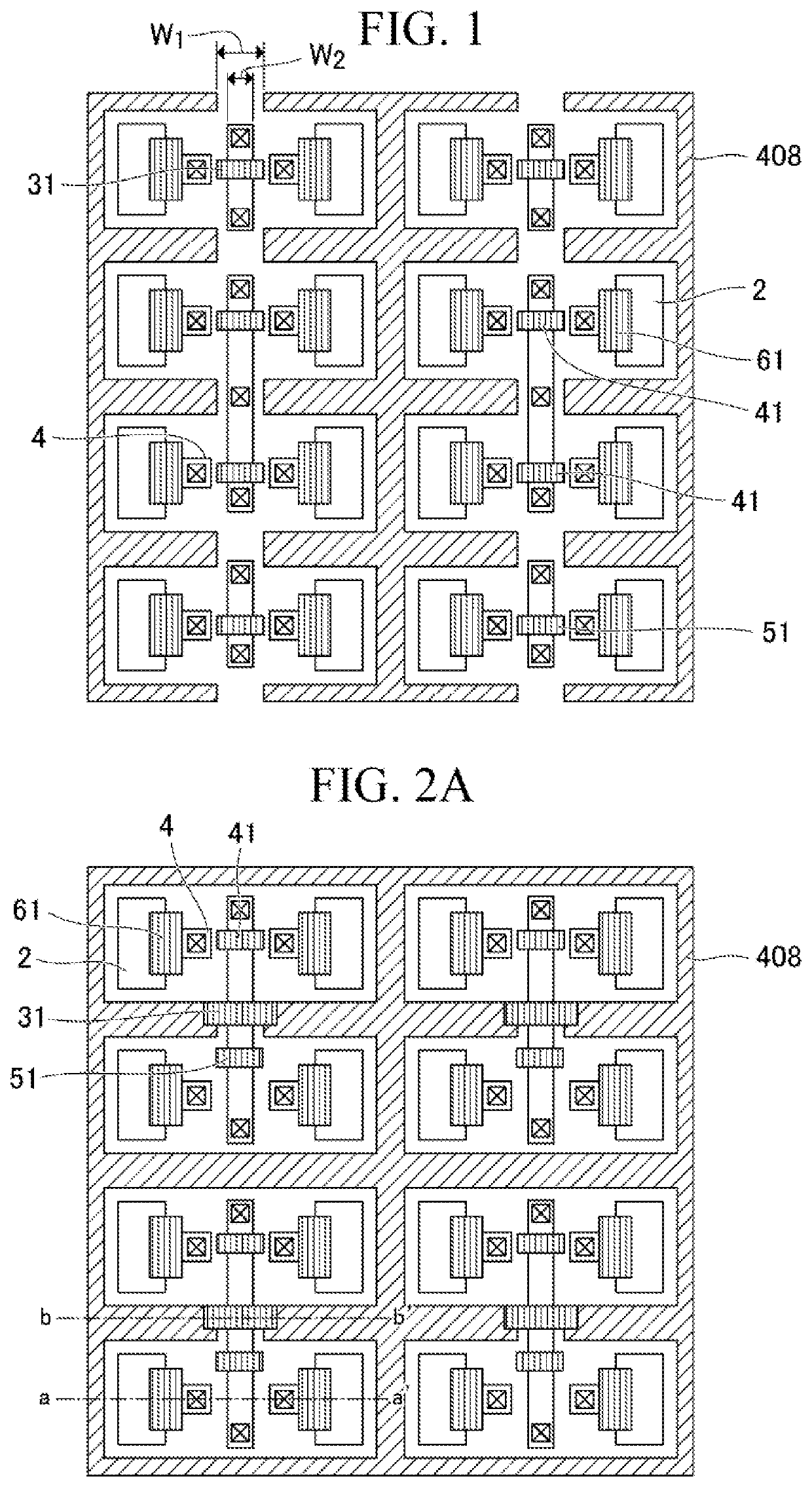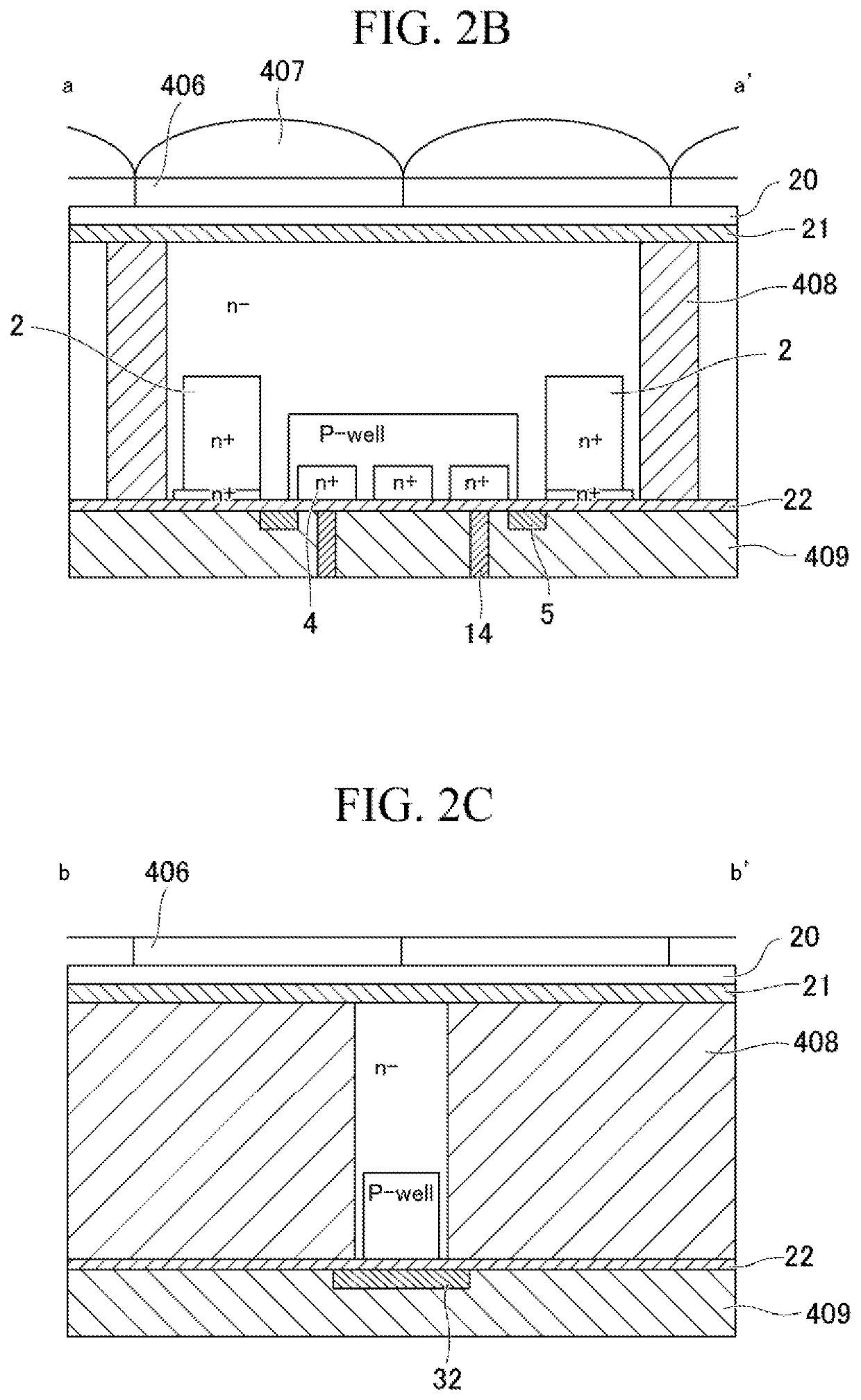Solid-state imaging device
a solid-state imaging and imaging device technology, applied in the direction of radio-controlled devices, transistors, television systems, etc., can solve the problem of limited area or the shape of the arranged photodiodes, and achieve the effect of preventing crosstalk and color mixing
- Summary
- Abstract
- Description
- Claims
- Application Information
AI Technical Summary
Benefits of technology
Problems solved by technology
Method used
Image
Examples
first embodiment
[0025]A first embodiment of the present invention will be described. FIG. 1 is a plan view showing a configuration of a pixel array in the solid-state imaging device according to the first embodiment of the present invention. In the pixel array, unit pixels are two-dimensionally arranged on the semiconductor substrate 404. In FIG. 1, 16 unit pixels of “4 pixels in the horizontal direction”ד4 pixels in the vertical direction” are arranged.
[0026]The element isolation insulating film (element isolation region) 408 is formed of an insulating film having a refractive index lower than that of the silicon layer of the semiconductor substrate. In Patent Document 1, the element isolation insulating film 408 is provided at all boundary portions between adjacent unit pixels on the semiconductor substrate. However, in the first embodiment of the present invention, as shown in FIG. 1, among the element isolation insulating film 408 surrounding each unit pixel, the element isolation insulating f...
second embodiment
[0036]A second embodiment of the present invention will be described. FIG. 2A is a plan view showing the configuration of the pixel array in the solid-state imaging device according to the second embodiment of the present invention. As in FIG. 1, in the pixel array, unit pixels are two-dimensionally arranged on the semiconductor substrate 404, and 16 unit pixels of “4 pixels in the horizontal direction”ד4 pixels in the vertical direction” are arranged.
[0037]A difference from the configuration in FIG. 1 is that in FIG. 2A, four unit pixels of “2 pixels in the horizontal direction”ד2 pixels in the vertical direction” share various transistors. Therefore, as shown in FIG. 2A, among the element isolation insulating films 408 surrounding each unit pixel, the element isolation insulating film 408 of one side that separates adjacent unit pixels and the element isolation insulating film 408 positioned above or below the one side are omitted.
[0038]Also in the configuration of FIG. 2A, the ...
third embodiment
[0050]A third embodiment of the present invention will be described. FIG. 3 is a plan view showing the configuration of the pixel array in the solid-state imaging device according to the third embodiment of the present invention. In FIG. 3, in the pixel array, unit pixels are two-dimensionally arranged on the semiconductor substrate 404, and eight unit pixels of “2 pixels in the horizontal direction”ד4 pixels in the vertical direction” are arranged. The form of the element isolation insulating film 408 in the configuration of FIG. 3 is the same as the form of the element isolation insulating film 408 in FIG. 2A.
[0051]The difference from the configuration of FIG. 2A is that in the configuration of FIG. 3, various transistors and their active areas are not shared between unit pixels. In the configuration of FIG. 3, various transistors other than the transfer transistor 61 and their active areas are arranged in the vertical direction at intermediate portions of the floating diffusions...
PUM
 Login to View More
Login to View More Abstract
Description
Claims
Application Information
 Login to View More
Login to View More - R&D
- Intellectual Property
- Life Sciences
- Materials
- Tech Scout
- Unparalleled Data Quality
- Higher Quality Content
- 60% Fewer Hallucinations
Browse by: Latest US Patents, China's latest patents, Technical Efficacy Thesaurus, Application Domain, Technology Topic, Popular Technical Reports.
© 2025 PatSnap. All rights reserved.Legal|Privacy policy|Modern Slavery Act Transparency Statement|Sitemap|About US| Contact US: help@patsnap.com



